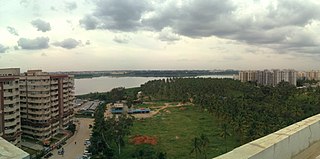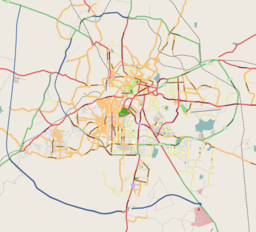The Birdwatchers' Field Club of Bangalore is a birdwatching club in Bangalore founded in the 1970s.

Sankey tank, a manmade lake or tank, is situated in the western part of Bangalore in the middle of the neighbourhoods of Malleshwaram, Vyalikaval and Sadashivanagar. The lake covers an area of about 15 ha. At its widest, the tank has a width of 800 m (2,624.7 ft).

Bruhat Bengaluru Mahanagara Palike (BBMP) is the administrative body responsible for civic amenities and some infrastructural assets of the Greater Bengaluru metropolitan area. It is the fourth largest Municipal Corporation in India and is responsible for a population of 8.4 million in an area of 741 km2. Its boundaries have expanded more than 10 times over the last six decades.
Bengaluru is the capital and the largest city of the Indian state of Karnataka. It is India's third largest city and fifth largest metropolitan area. Modern Bengaluru was founded in 1537 CE by Kempe Gowda, a vassal of the Vijayanagara Empire. Kempe Gowda built a mud fort in the vicinity of modern Bengaluru. By 1831, the city was incorporated into the British Raj with the establishment of the Bangalore Cantonment. The British returned dominion of the city to the King of Mysore, choosing however, to retain jurisdiction over the cantonment. Therefore, Bengaluru essentially became a twin city, with civic and infrastructural developments of the cantonment conforming to European styles of planning.

Hebbal Lake is located in the north of Bangalore at the mouth of National Highway 7, along the junction of Bellary Road and the Outer Ring Road (ORR). It was one of the three lakes created in 1537 by Kempe Gowda. Like most lakes or "tanks" in the Bangalore region it was formed by the damming natural valley systems by the construction of bunds. The spread of the lake in a study in 2000 was found to be 75 ha with plans for extending it to make up 143 ha.

Madiwala lake is one of the biggest lakes in Bangalore, India spread over an area of 114.3 hectare. The water in the lake was fit for drinking till the early 1990s. Since then it has become unfit for drinking due to industrial waste and sewage entering the waterbody. It has gradually become polluted.
Lakes and tanks in the metropolitan area of Greater Bangalore and the district of Bangalore Urban are reservoirs of varying sizes constructed over a number of centuries by various empires and dynasties for rainwater harvesting. Historically, these reservoirs were primarily either irrigation tanks or for the water supply, with secondary uses such as bathing and washing. The need for creating and sustaining these man-made dammed freshwater reservoirs was created by the absence of a major river nearby coupled with a growing settlement. As Bangalore grew from a small settlement into a city, both of the primary historical uses of the tanks changed. Agricultural land witnessed urbanization and alternate sources of water were provisioned, such as through borewells, piped reservoir water and later river water from further away.

Bellandur Lake is located in the suburb of Bellandur in the southeast of the city of Bengaluru. It is the largest lake in the city. It is a part of Bellandur drainage system that drains the southern and the south-eastern parts of the city. The lake is a receptor from three chains of lakes upstream, and has a catchment area of about 148 square kilometres. Water from this lake flows further east to the Varthur Lake, from where it flows down the plateau and eventually into the Pinakani river basin.

Agara lake is an 80-acre lake located in Agara, Bangalore. It is part of the Varthur lake series. Madiwala Lake is upstream while Bellandur Lake is downstream. Inter-lake connections have seen fragmentation and urbanisation.
Yelahanka Lake is a water body near Yelahanka, a suburb of Bangalore.

Bengaluru, formerly called Bangalore in English, is the capital and largest city of the southern Indian state of Karnataka. It has a population of more than 8 million and a metropolitan population of around 15 million, making it India's third most populous city and fourth most populous urban agglomeration. It is the most populous city and largest urban agglomeration in South India, and is the 27th largest city in the world. Located on the Deccan Plateau, at a height of over 900 m (3,000 ft) above sea level, Bengaluru has a pleasant climate throughout the year, with its parks and green spaces earning it the reputation of India's "Garden City". Its elevation is the highest of India's major cities.

The Thurahalli Forest or Thurahalli Park is a dry and deciduous forest. It is located about 20 km from Bengaluru off Kanakapura Road. It is 13 km from Banashankari and can be overseen from the NICE road. Entry inside the park has been banned for vehicles, however, it has become a hot spot for cyclists.

D. Kupendra Reddy an Indian politician, entrepreneur and a social worker. He is a former Member of Parliament in the Rajya Sabha, the upper house of the Parliament of India from 2014 to 2020. He is representing Karnataka from Janata Dal (Secular) party, a regional political party headed by H D Deve Gowda, former Prime Minister of India..

Bannerghatta Biological Park, also known as the Bannerghatta Zoo, is a zoological garden located in the city of Bengaluru. It was initially a small zoo and picnic corner within Bannerghatta National Park (BNP) which was started in 1974. The bifurcation of the Biological Park and the National Park took place in 2002. The Bannerghatta Biological Park covers a total area of 731.88 hectares and includes a zoo, safari park, butterfly park and rescue centre. The Zoo Authority of Karnataka, the University of Agricultural Sciences, Bangalore, and the Ashoka Trust for Research in Ecology and Environment (ATREE), Bangalore, are collaborating agencies. For the convenience of the general public, the Governing Council of Zoo Authority of Karnataka had decided to rename Bannerghatta Biological Park as 'Bengaluru Bannerghatta Biological Park' (BBBP).

Jakkur is a suburb in the northern part of Bangalore, Karnataka, India. Located on the eastern side of the National Highway 44 between Yelahanka and Hebbal, the area is best known for the Jakkur Aerodrome and Jakkur lake.
The Lake Development Authority (LDA) in Bangalore, Karnataka, and its successor the Karnataka Lake Conservation and Development Authority (KCLDA) were formed in 2002 and 2015 respectively. Karnataka Tank Conservation and Development Authority (KTCDA) under the Minor Irrigation Department became the superseding agency.
Jaraganahalli Lake was a lake in the southern part of Bengaluru, India.
Harini Nagendra is an Indian ecologist who uses satellite remote sensing coupled with field studies of biodiversity, archival research, institutional analysis, and community interviews to examine the factors shaping the social-ecological sustainability of forests and cities in the south Asian context. Her areas of interest include Urban sustainability, Ecology and development, Land change, Biodiversity and conservation.

Yele Mallappa Shetty Lake is one of the largest lakes in Bangalore, located on the eastern side of the city, outside of KR Puram. It is an artificial water reservoir constructed in early 1900s. The lake is spread over 490 acres (198.3 ha).
Anand Malligavad, known as the Lakeman of India, is an Indian water conservationist and environmentalist from Bengaluru. He is known for his contribution in the revitalization of 23 deteriorating lakes in Bengaluru.
















